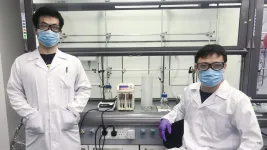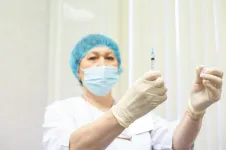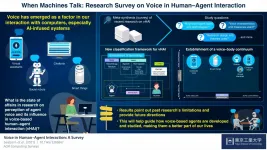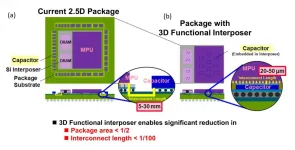Chimeric viruses unearth hidden gems in dengue virus structure
2021-06-01
(Press-News.org) In a recent study, Australian scientists used an original approach to resolve the 3D structure of flaviviruses with an unprecedented level of detail, identifying small molecules known as 'pocket factors' as new therapeutic targets.
Flaviviruses infect humans by mosquito or tick bite, with symptoms ranging from fever and myalgia to life-threatening neurological and congenital conditions. Flaviviruses such as dengue, yellow fever and Zika threaten almost a third of the world's population, and new flaviviruses emerge regularly from animal reservoirs with the potential to cause epidemics.
There are currently no approved antiviral drugs for flavivirus infection and most flaviviruses lack a vaccine. Structures of infectious particles are essential to map the vulnerabilities in the viral outer surface to design better therapeutics. However, structure determination of highly pathogenic flaviviruses is only possible in very few locations across the world where microscopes are contained in high biosecurity environments.
In the study, published in Nature Communications, a team led by Associate Professor Fasséli Coulibaly from Monash University and Associate Professor Daniel Watterson from the University of Queensland, have generated three new flavivirus structures using an approach that does not require the same level of containment.
This approach takes advantage of a unique flavivirus first isolated from mosquitoes in the Binjari area. The virus has no known vertebrate - specifically human - host, making it easy to manipulate without risk of human infection. The researchers used the Binjari virus as a platform to produce benign chimeric viruses with the outer shell of medically-relevant viruses.
The team used the Ramaciotti Centre for Cryo-Electron Microscopy at Monash University to determine structures of the chimeric particles. They found that these viruses mimic the infectious particles of several pathogenic flaviviruses in the finest details. This provides a universal path to the safe and rapid structure determination for existing and emerging flaviviruses.
"Because the structural proteins are derived from the human-infecting virus, the particles look like the pathogenic virus. It means that we can determine the structure of these proteins in a native context and that these particles can be used for vaccinal and diagnostic purposes," said Associate Professor Watterson.
Associate Professor Coulibaly said the level of detail of these models was unprecedented with the ability to visualise water molecules and tiny pocket factors nestled within the infectious particles.
"Due to the impressive resolution of our structures we were able to build accurate models for these viruses. We saw how the pocket factors bind to conserved parts found in all pathogenic flaviviruses. Their location suggests they could be the final linchpin to ensure the infectious particle is securely fastened before its release from the cell," he said.
INFORMATION:
This study builds on the progress made by the research team in understanding flavivirus maturation published recently in Science Advances. Together the studies identify the uptake of pocket factors as a potential target for the design of broad-spectrum therapeutics.
The joint first authors are Dr Joshua Hardy in the Coulibaly lab of the Biomedicine Discovery Institute at Monash University and Dr Natalee Newton in the Watterson lab at the University of Queensland.
Read the full paper in Nature Communications titled: A unified route for flavivirus structures uncovers essential pocket factors conserved across pathogenic viruses.
DOI: 10.1038/s41467-021-22773-1
About the Monash Biomedicine Discovery Institute at Monash University
Committed to making the discoveries that will relieve the future burden of disease, the newly established Monash Biomedicine Discovery Institute at Monash University brings together more than 120 internationally-renowned research teams. Spanning six discovery programs across Cancer, Cardiovascular Disease, Development and Stem Cells, Infection and Immunity, Metabolism, Diabetes and Obesity, and Neuroscience, Monash BDI is one of the largest biomedical research institutes in Australia. Our researchers are supported by world-class technology and infrastructure, and partner with industry, clinicians and researchers internationally to enhance lives through discovery.
For Media Enquiries please contact:
Wendy Smith - Communications Manager Monash University
E: wendy.smith1@monash.edu
T: +61 (0) 425 725 836
For more Monash media stories, visit our news and events site
[Attachments] See images for this press release:
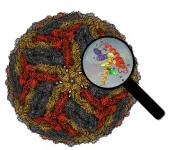
ELSE PRESS RELEASES FROM THIS DATE:
2021-06-01
A research team led by scientists at Université de Montréal has developed a unique observational tool for assessing children up to 5 years of age who have had a concussion. The work is explained in a study published in the Journal of Head Trauma Rehabilitation.
Pediatric traumatic brain injury (TBI) is particularly prevalent in toddlers; they're more likely to be injured because they have a lower sense of danger and are still developing physically. But parents and clinicians have trouble detecting symptoms of trauma, given the toddler's limited verbal skills.
"A young child will not tell you that they have a headache or feel dizzy," said Dominique Dupont, an UdeM postdoctoral student in neuropsychology and first author of the study.
"But assessing post-concussion symptoms ...
2021-06-01
PHILADELPHIA--An odor-based test that sniffs out vapors emanating from blood samples was able to distinguish between benign and pancreatic and ovarian cancer cells with up to 95 percent accuracy, according to a new study from researchers at the University of Pennsylvania and Penn's Perelman School of Medicine.
The findings suggest that the Penn-developed tool -- which uses artificial intelligence and machine learning to decipher the mixture of volatile organic compounds (VOCs) emitting off cells in blood plasma samples -- could serve as a non-invasive approach ...
2021-06-01
Our lives today are governed by electronics in all shapes and forms. Electronics, in turn, are governed by their batteries. However, the traditional lithium-ion batteries (LIBs), that are widely used in electronic devices, are falling out of favor because researchers are beginning to view lithium metal batteries (LMBs) as a superior alternative due to their remarkably high energy density that exceeds LIBs by an order of magnitude! The key difference lies in the choice of anode material: LIBs use graphite, whereas LMBs use lithium metal.
Such a choice, however, comes with its own challenges. Among the most prominent ones is the formation ...
2021-06-01
Singapore, 1 June 2021 - The discovery and development of new small-molecule compounds for therapeutic use involves a huge investment of time, effort and resources. Giving a new spin to conventional chemical synthesis, a team of researchers from the National University of Singapore (NUS) has developed a way to automate the production of small molecules suitable for pharmaceutical use. The method can potentially be used for molecules that are typically produced via manual processes, thereby reducing the manpower required.
The research team that achieved this technological breakthrough was led by Assistant Professor Wu Jie from the NUS Department of Chemistry as well as Associate Professor Saif A. Khan from ...
2021-06-01
Bribery in the public healthcare does not solve the problem of poor quality of services, and even exacerbates it, researchers argue. The same can be said about the well-being of patients and their own assessment of health. In other words, bribes in the healthcare do not provide good quality services and do not pay off. Such conclusions were reached by an international team of researchers, including Olga Popova, the article's co-author, an associate professor at the Ural Federal University (UrFU, Russia).
Researchers examined survey data on 41,000 citizens from 28 post-communist countries in Central and Eastern Europe, as well as ...
2021-06-01
Tokyo - Machine learning is the process by which computers adapt their responses without human intervention. This form of artificial intelligence (AI) is now common in everyday tools such as virtual assistants and is being developed for use in areas from medicine to agriculture. A challenge posed by the rapid expansion of machine learning is the high energy demand of the complex computing processes. Researchers from The University of Tokyo have reported the first integration of a mobility-enhanced field-effect transistor (FET) and a ferroelectric capacitor (FE-CAP) to bring the memory system into the proximity of a microprocessor and improve the ...
2021-06-01
In the modern day, our interactions with voice-based devices and services continue to increase. In this light, researchers at Tokyo Institute of Technology and RIKEN, Japan, have performed a meta-synthesis to understand how we perceive and interact with the voice (and the body) of various machines. Their findings have generated insights into human preferences, and can be used by engineers and designers to develop future vocal technologies.
As humans, we primarily communicate vocally and aurally. We convey not just linguistic information, but also the complexities of our emotional states and personalities. Aspects of our voice such as tone, rhythm, and pitch are vital to the way we are perceived. In other words, the way we say things matters.
With advances in ...
2021-06-01
Magnetic fields are ubiquitous throughout our Milky Way Galaxy and play a crucial role in all dynamics of interstellar medium. However, questions like how Solar-type stars form out of magnetized molecular clouds, whether the role of magnetic fields changes at various scales and densities of molecular clouds, and what factors can change the morphology of magnetic fields in low-mass dense cores still remain unclear.
A new study led by Dr. Eswaraiah Chakali from Prof. LI Di's research group at the National Astronomical Observatories of the Chinese Academy of Sciences (NAOC) has partially answered these questions. ...
2021-06-01
Scientists at Tokyo Institute of Technology develop a 3D functional interposer--the interface between a chip and the package substrate--containing an embedded capacitor. This compact design saves a lot of package area and greatly reduces the wiring length between the chip's terminals and the capacitor, allowing for less noise and power consumption. Their approach paves the way to new semiconductor package structures with greater miniaturization.
Electronics started big size-wise but have only grown smaller and more compact over time. Today, even smartphones outperform the bulky computers from the 1980s by orders of magnitude. Unfortunately, ...
2021-06-01
Up to three quarters of the biodiversity living on Western Australia's iconic ironstone mountains in the State's Mid West (known as Banded Iron Formations) could be difficult or impossible to return quickly to its previous state after the landscape has been mined, a Curtin University study has found.
The research published in Ecology and Evolution, discovered that the plant ecosystems are well-adapted to the characteristics of the region's ancient and nutrient-poor soils - and that the very different features of mined landscapes mean many native species are unlikely to be returned by rehabilitation.
Lead researcher Dr Adam Cross ...
LAST 30 PRESS RELEASES:
[Press-News.org] Chimeric viruses unearth hidden gems in dengue virus structure


